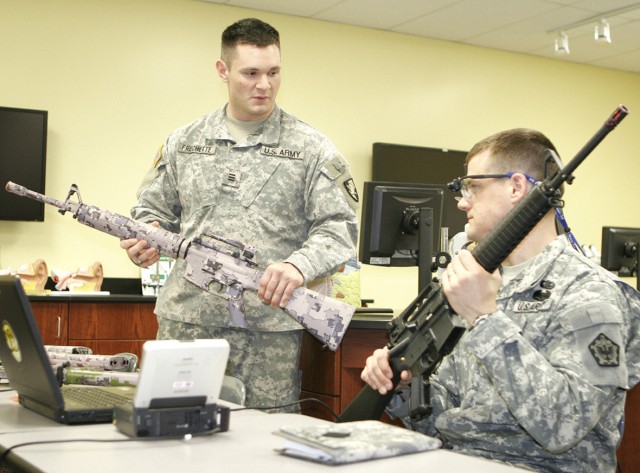
WEST POINT, N.Y. (June 3, 2010) -- Over the years, West Point has served as a sort of proving ground for improved camouflage. In the Engineering Psychology program within the Department of Behavioral Sciences and Leadership, faculty and cadets have done their part to advance the science of how not to be seen.
Dr. Timothy O'Neill is a camouflage consultant and a retired Army officer of 25 years, 15 of which were spent as an instructor here. During his tenure here, he founded the Engineering Psychology program and created the basis of the camouflage pattern on the Army Combat Uniform.
His work in camouflage began prior to graduate school with field testing at Fort Knox, Ky. While earning his doctorate, he picked up more ideas and brought them to the academy in 1976 as a first-year BS&L instructor. O'Neill created the "digital" camouflage concept, which he prefers to call texture match.
That year, his "Dual-Tex" pattern was tested here in the laboratory with the assistance of cadets and faculty. In May 1977, a research team, which included O'Neill, conducted a field test at Aberdeen Proving Ground, Md.
Where the squared pattern came from, O'Neill said, is an interesting story.
"I needed to have a texture that matched natural backgrounds for a variety of reasons," O'Neill said. "So we dragged a dead M113 armored personnel carrier out into the middle of a field ... and painted it by hand. We painted the pattern with a two-inch paint roller (to make two-inch squares)."
Painting "Dual-Tex" onto the APC was what O'Neill called "an eyeball process," because technology back then wasn't sophisticated enough to replicate the pattern. Still, it tested well against camouflage patterns the Army used at the time.
Since he retired in 1991, O'Neill served as a camouflage consultant for a variety of entities. He designed the Marine Corps' MARine PATtern, or MARPAT camouflage and worked with the Marines, Army, Office of Naval Research and Program Executive Office Soldier on various studies and adaptations of texture match.
Another camouflage-related project O'Neill worked on in the 1970s and '80s was eye tracking. This technology was pioneered at West Point when the Engineering Psychology program conducted a number of studies on how the human visual system detects and recognizes camouflaged targets.
"Detecting a target is very complex-it involves both sensory and cognitive functions," O'Neill said. "There's not only the eye and brain interacting to find something, but there's also decision-making that's going on in the brain."
Two semesters ago, O'Neill and a team of cadets tested texture match samples on uniforms and rifles using a modern eye-tracking system-a set of shooting glasses with two tiny video cameras mounted on the frame, which feeds visual data via to a computer.
The cameras measure the cornea and reflections off the retina to compute the angle and location which the eye is looking. Using this system, the team could measure the time it took to see the camouflaged objects and decide whether or not it was a target.
Second Lt. Jacob Frechette, a Fenton, Ill., native, was one of the engineering psychology majors who assisted O'Neill.
He learned how many human factors, from time of day to comfort level of the observer, can affect how effective the camouflage samples were.
"There's a lot more (science) to it than putting some colors in a random pattern," Frechette said. "It was a great way of bringing together all the skills we learned in biopsychology, cognitive psychology and engineering psychology."
The science of engineering psychology includes the limits of human perception, sensation, and what the body itself is capable of. Frechette says this major taught him about how Soldiers think and feel, and what equipment his own Soldiers may use once he is commissioned as an aviation lieutenant.
"This is definitely one of most applicable majors for being an officer in the military," Frechette said.
Last year, O'Neill was commissioned by Army PEO Soldier at Fort Belvoir, Va., to assist in the redesign of the ACU.
He is also working closely with Natick Soldier Systems Center in Massachusetts, Soldier Requirements Division at Fort Benning, Ga., and other agencies.
The aim of the project-which is still in research and development-is to reduce the number of Soldier uniform patterns to a practical minimum. The creation of those patterns will be driven primarily by their effectiveness in different combat environments, as well as how visually appealing they are. The latter goal is what the researchers call the "CDI factor" -or, "chicks dig it," O'Neill said, because in addition to working well in the field, "it has to look good."
O'Neill personally believes the end state will be two uniforms with snow overwhites. Though he is currently unable to discuss any particulars about the new uniform, O'Neill assures that they are developing it as fast as they can.
"Most people currently on active duty today will see the new uniform before they retire," O'Neill said.

Social Sharing